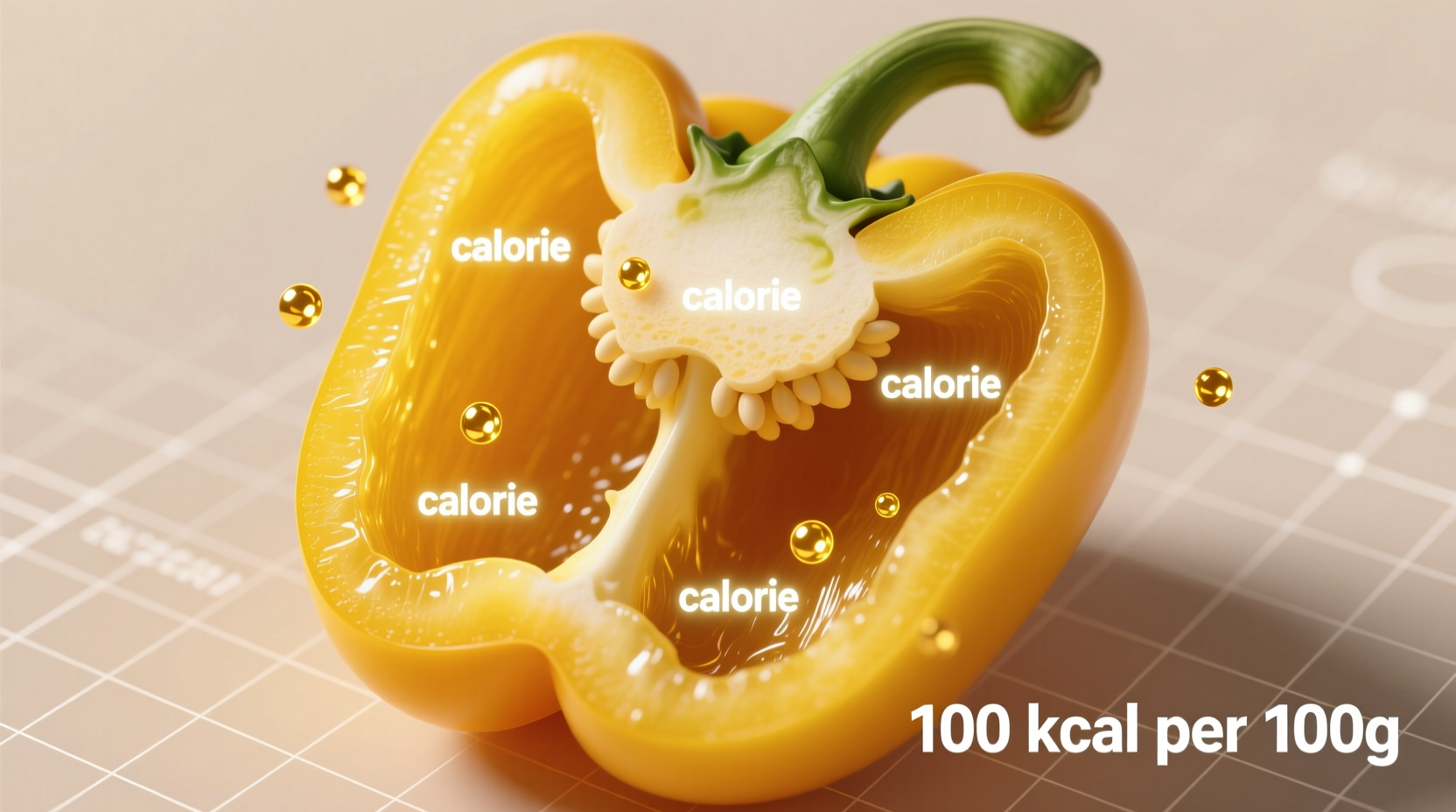A medium yellow bell pepper (120g) contains just 37 calories, making it an exceptionally low-calorie vegetable packed with essential nutrients. This vibrant pepper provides 158% of your daily vitamin C needs while delivering fiber, antioxidants, and virtually no fat.
Curious about how this colorful vegetable fits into your healthy eating plan? Whether you're tracking macros, managing weight, or simply looking to boost your nutrition, understanding the precise caloric value of yellow bell peppers helps you make informed food choices without sacrificing flavor or satisfaction.
Why Yellow Bell Pepper Calories Matter for Your Diet
Yellow bell peppers represent one of nature's most efficient nutrient delivery systems. With only 30 calories per 100 grams, they offer exceptional nutritional density that supports various dietary goals. Registered dietitians consistently recommend incorporating colorful bell peppers into meal plans because they provide substantial volume and satisfaction with minimal caloric impact. This makes them particularly valuable for weight management strategies where calorie awareness matters without compromising on nutrient intake.

Exact Calorie Count Across Serving Sizes
Understanding precise measurements helps when tracking your nutritional intake. The USDA FoodData Central database provides these verified calorie counts for raw yellow bell peppers:
| Serving Size | Calories | Carbohydrates | Fiber |
|---|---|---|---|
| 1 cup, chopped (150g) | 49 | 11.5g | 3.1g |
| 1 medium pepper (120g) | 37 | 9.2g | 2.5g |
| 100 grams | 31 | 7.7g | 2.1g |
These values come directly from the USDA FoodData Central database, the gold standard for nutritional information in the United States. The fiber content significantly contributes to the pepper's low net carb count, making it suitable for various dietary approaches including keto and diabetic meal planning.
Yellow vs. Other Colored Bell Peppers: Nutritional Comparison
While all bell peppers share similar nutritional profiles, subtle differences exist between colors. As bell peppers ripen from green to yellow to red, their nutritional composition changes:
| Nutrient (per 100g) | Green Bell Pepper | Yellow Bell Pepper | Red Bell Pepper |
|---|---|---|---|
| Calories | 20 | 31 | 31 |
| Vitamin C | 80mg (133% DV) | 183mg (305% DV) | 190mg (317% DV) |
| Vitamin A | 313 IU | 3,225 IU | 3,726 IU |
| Antioxidants | Moderate | High | Highest |
Yellow bell peppers contain significantly more vitamin C than their green counterparts, though slightly less than fully ripe red peppers. The ripening process increases sugar content slightly (explaining the higher calorie count compared to green peppers), but dramatically boosts antioxidant levels. According to research published in the Journal of Agricultural and Food Chemistry, the carotenoid content in yellow peppers provides potent anti-inflammatory benefits.
Practical Ways to Enjoy Yellow Bell Peppers Without Counting Calories
The beauty of yellow bell peppers lies in their versatility. Here's how to maximize their culinary potential while maintaining awareness of portion sizes:
- Raw in salads: Add 1 cup chopped (49 calories) to boost volume and nutrients without significantly increasing calorie count
- Stuffed peppers: Use half a medium pepper (18 calories) as an edible container for lean protein fillings
- Roasted vegetable medley: Combine with other low-calorie vegetables like zucchini and mushrooms for a flavorful side dish
- Stir-fries: Add 1 cup sliced (49 calories) to increase vegetable content in Asian-inspired dishes
- Healthy dips: Slice into strips (37 calories per medium pepper) for pairing with hummus or Greek yogurt-based dips
Professional chefs like those at the James Beard Foundation recommend roasting yellow bell peppers to concentrate their natural sweetness, which enhances flavor without adding calories. This technique makes smaller portions feel more satisfying, supporting mindful eating practices.
How Cooking Methods Affect Calorie Content
While raw yellow bell peppers maintain their precise nutritional profile, cooking methods can influence both calorie density and nutrient availability:
- Raw consumption: Preserves maximum vitamin C content but may be harder to digest for some individuals
- Roasting: Concentrates natural sugars slightly but increases bioavailability of carotenoids by breaking down cell walls
- Steaming: Maintains most nutrients while improving digestibility with minimal impact on calorie count
- Sautéing: Adds calories only if oil is used (1 teaspoon olive oil adds 40 calories)
A study from the International Journal of Food Science & Technology found that moderate cooking actually enhances the antioxidant capacity of yellow bell peppers despite minor vitamin C loss. This demonstrates that both raw and cooked preparations offer valuable nutritional benefits with minimal caloric impact.
Beyond Calories: The Complete Nutritional Profile
While calorie count matters for many people, yellow bell peppers deliver remarkable nutritional value beyond just energy content. A single medium pepper provides:
- 158% of your daily vitamin C requirement - crucial for immune function and skin health
- 15% of vitamin B6 - supports metabolism and brain health
- 10% of vitamin K1 - essential for blood clotting and bone health
- 8% of potassium - helps regulate blood pressure
- Significant amounts of vitamin E and multiple carotenoids including lutein and zeaxanthin
This impressive nutrient density explains why registered dietitians consistently recommend yellow bell peppers as a foundational vegetable in balanced diets. The combination of fiber, vitamins, and antioxidants supports multiple aspects of health while contributing minimally to daily calorie intake.
Common Questions About Yellow Bell Pepper Nutrition
Understanding the nuances of yellow bell pepper nutrition helps you make the most of this vibrant vegetable in your daily eating habits.











 浙公网安备
33010002000092号
浙公网安备
33010002000092号 浙B2-20120091-4
浙B2-20120091-4